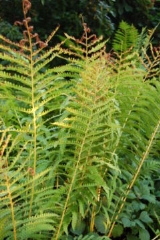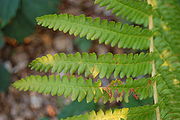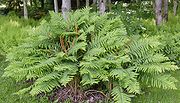
Cinnamon fern
Encyclopedia
Osmundastrum cinnamomeum, the Cinnamon Fern, is a species of eusporangiate fern
in the family Osmundaceae
. It is native to the Americas
and eastern Asia
, growing in swamps, bogs and moist woodlands.
In North America
it occurs from southern Labrador
west to Ontario
, and south through the eastern
United States
to eastern Mexico
and the West Indies; in South America
it occurs west to Peru
and south to Paraguay
. In Asia it occurs from southeastern Siberia
south through Japan
, Korea
, China
and Taiwan
to Myanmar
, Thailand
and Vietnam
.
 Osmundastrum cinnamomeum is a deciduous
Osmundastrum cinnamomeum is a deciduous
herbaceous
plant which produces separate fertile and sterile frond
s. The sterile fronds are spreading, 30-150 cm tall and 15-20 cm broad, pinnate, with pinnae 5-10 cm long and 2-2.5 cm broad, deeply lobed (so the fronds are nearly, but not quite, bipinnate). The fertile spore
-bearing fronds are erect and shorter, 20-45 cm tall; they become cinnamon
-colored, which gives the species its name. The fertile leaves appear first; their green color slowly becomes brown as the season progresses and the spores are dropped. The spore-bearing stems persist after the sterile fronds are killed by frost, until the next season. The spores must develop within a few weeks or fail.
The Osmundastrum cinnamomeum fern forms huge clonal colonies in swamp
y areas. These ferns form massive rootstocks with densely-matted, wiry roots. This root mass is an excellent substrate for many epiphytal
plants. They are often harvested as osmunda fiber and used horticulturally
, especially in propagating and growing orchids. Cinnamon Ferns do not actually produce cinnamon.
. Cladistically
, it is either necessary then to include all species of the Osmundaceae, including Todea
and Leptopteris
in the genus Osmunda
, or else it is necessary to segregate the genus Osmundastrum. O. cinnamomeum is the sole living species in the genus, although it is possible that some additional fossils should be assigned to Osmundastrum.
Formerly, some authors included the interrupted fern, Osmunda claytoniana, in the genus or section Osmundastrum, because of its gross apparent morphological similarities. However, detailed morphology and genetic analysis have proven that the interrupted fern is actually a true Osmunda. This is borne out by the fact that it is known to hybridize with the American royal fern, Osmunda spectabilis
to produce Osmunda × ruggii
in a family in which hybrids are rare, while Osmundastrum cinnamomeum has no known hybrids.
Osmundastrum cinnamomeum is considered a living fossil
because it has been identified in the geologic record as far back as 75 million years ago.
The Asian and American populations of cinnamon fern are generally considered to be varieties of a single species, but some botanists classify them as separate species.

Eusporangiate fern
Eusporangiate ferns are vascular spore plants, whose sporangia arise from several epidermal cells and not from a single cell as in leptosporangiate ferns...
in the family Osmundaceae
Osmundaceae
The Osmundaceae is a family of four genera and 15-25 species. It is the only fern family of the order Osmundales; an order in the class Pteridopsida or in some classifications the only order in the class Osmundopsida...
. It is native to the Americas
Americas
The Americas, or America , are lands in the Western hemisphere, also known as the New World. In English, the plural form the Americas is often used to refer to the landmasses of North America and South America with their associated islands and regions, while the singular form America is primarily...
and eastern Asia
Asia
Asia is the world's largest and most populous continent, located primarily in the eastern and northern hemispheres. It covers 8.7% of the Earth's total surface area and with approximately 3.879 billion people, it hosts 60% of the world's current human population...
, growing in swamps, bogs and moist woodlands.
In North America
North America
North America is a continent wholly within the Northern Hemisphere and almost wholly within the Western Hemisphere. It is also considered a northern subcontinent of the Americas...
it occurs from southern Labrador
Labrador
Labrador is the distinct, northerly region of the Canadian province of Newfoundland and Labrador. It comprises the mainland portion of the province, separated from the island of Newfoundland by the Strait of Belle Isle...
west to Ontario
Ontario
Ontario is a province of Canada, located in east-central Canada. It is Canada's most populous province and second largest in total area. It is home to the nation's most populous city, Toronto, and the nation's capital, Ottawa....
, and south through the eastern
Eastern United States
The Eastern United States, the American East, or simply the East is traditionally defined as the states east of the Mississippi River. The first two tiers of states west of the Mississippi have traditionally been considered part of the West, but can be included in the East today; usually in...
United States
United States
The United States of America is a federal constitutional republic comprising fifty states and a federal district...
to eastern Mexico
Mexico
The United Mexican States , commonly known as Mexico , is a federal constitutional republic in North America. It is bordered on the north by the United States; on the south and west by the Pacific Ocean; on the southeast by Guatemala, Belize, and the Caribbean Sea; and on the east by the Gulf of...
and the West Indies; in South America
South America
South America is a continent situated in the Western Hemisphere, mostly in the Southern Hemisphere, with a relatively small portion in the Northern Hemisphere. The continent is also considered a subcontinent of the Americas. It is bordered on the west by the Pacific Ocean and on the north and east...
it occurs west to Peru
Peru
Peru , officially the Republic of Peru , is a country in western South America. It is bordered on the north by Ecuador and Colombia, on the east by Brazil, on the southeast by Bolivia, on the south by Chile, and on the west by the Pacific Ocean....
and south to Paraguay
Paraguay
Paraguay , officially the Republic of Paraguay , is a landlocked country in South America. It is bordered by Argentina to the south and southwest, Brazil to the east and northeast, and Bolivia to the northwest. Paraguay lies on both banks of the Paraguay River, which runs through the center of the...
. In Asia it occurs from southeastern Siberia
Siberia
Siberia is an extensive region constituting almost all of Northern Asia. Comprising the central and eastern portion of the Russian Federation, it was part of the Soviet Union from its beginning, as its predecessor states, the Tsardom of Russia and the Russian Empire, conquered it during the 16th...
south through Japan
Japan
Japan is an island nation in East Asia. Located in the Pacific Ocean, it lies to the east of the Sea of Japan, China, North Korea, South Korea and Russia, stretching from the Sea of Okhotsk in the north to the East China Sea and Taiwan in the south...
, Korea
Korea
Korea ) is an East Asian geographic region that is currently divided into two separate sovereign states — North Korea and South Korea. Located on the Korean Peninsula, Korea is bordered by the People's Republic of China to the northwest, Russia to the northeast, and is separated from Japan to the...
, China
China
Chinese civilization may refer to:* China for more general discussion of the country.* Chinese culture* Greater China, the transnational community of ethnic Chinese.* History of China* Sinosphere, the area historically affected by Chinese culture...
and Taiwan
Taiwan
Taiwan , also known, especially in the past, as Formosa , is the largest island of the same-named island group of East Asia in the western Pacific Ocean and located off the southeastern coast of mainland China. The island forms over 99% of the current territory of the Republic of China following...
to Myanmar
Myanmar
Burma , officially the Republic of the Union of Myanmar , is a country in Southeast Asia. Burma is bordered by China on the northeast, Laos on the east, Thailand on the southeast, Bangladesh on the west, India on the northwest, the Bay of Bengal to the southwest, and the Andaman Sea on the south....
, Thailand
Thailand
Thailand , officially the Kingdom of Thailand , formerly known as Siam , is a country located at the centre of the Indochina peninsula and Southeast Asia. It is bordered to the north by Burma and Laos, to the east by Laos and Cambodia, to the south by the Gulf of Thailand and Malaysia, and to the...
and Vietnam
Vietnam
Vietnam – sometimes spelled Viet Nam , officially the Socialist Republic of Vietnam – is the easternmost country on the Indochina Peninsula in Southeast Asia. It is bordered by China to the north, Laos to the northwest, Cambodia to the southwest, and the South China Sea –...
.
Characteristics

Deciduous
Deciduous means "falling off at maturity" or "tending to fall off", and is typically used in reference to trees or shrubs that lose their leaves seasonally, and to the shedding of other plant structures such as petals after flowering or fruit when ripe...
herbaceous
Herbaceous
A herbaceous plant is a plant that has leaves and stems that die down at the end of the growing season to the soil level. They have no persistent woody stem above ground...
plant which produces separate fertile and sterile frond
Frond
The term frond refers to a large, divided leaf. In both common usage and botanical nomenclature, the leaves of ferns are referred to as fronds and some botanists restrict the term to this group...
s. The sterile fronds are spreading, 30-150 cm tall and 15-20 cm broad, pinnate, with pinnae 5-10 cm long and 2-2.5 cm broad, deeply lobed (so the fronds are nearly, but not quite, bipinnate). The fertile spore
Spore
In biology, a spore is a reproductive structure that is adapted for dispersal and surviving for extended periods of time in unfavorable conditions. Spores form part of the life cycles of many bacteria, plants, algae, fungi and some protozoa. According to scientist Dr...
-bearing fronds are erect and shorter, 20-45 cm tall; they become cinnamon
Cinnamon
Cinnamon is a spice obtained from the inner bark of several trees from the genus Cinnamomum that is used in both sweet and savoury foods...
-colored, which gives the species its name. The fertile leaves appear first; their green color slowly becomes brown as the season progresses and the spores are dropped. The spore-bearing stems persist after the sterile fronds are killed by frost, until the next season. The spores must develop within a few weeks or fail.
The Osmundastrum cinnamomeum fern forms huge clonal colonies in swamp
Swamp
A swamp is a wetland with some flooding of large areas of land by shallow bodies of water. A swamp generally has a large number of hammocks, or dry-land protrusions, covered by aquatic vegetation, or vegetation that tolerates periodical inundation. The two main types of swamp are "true" or swamp...
y areas. These ferns form massive rootstocks with densely-matted, wiry roots. This root mass is an excellent substrate for many epiphytal
Epiphyte
An epiphyte is a plant that grows upon another plant non-parasitically or sometimes upon some other object , derives its moisture and nutrients from the air and rain and sometimes from debris accumulating around it, and is found in the temperate zone and in the...
plants. They are often harvested as osmunda fiber and used horticulturally
Horticulture
Horticulture is the industry and science of plant cultivation including the process of preparing soil for the planting of seeds, tubers, or cuttings. Horticulturists work and conduct research in the disciplines of plant propagation and cultivation, crop production, plant breeding and genetic...
, especially in propagating and growing orchids. Cinnamon Ferns do not actually produce cinnamon.
Classification
Traditionally, this plant has been classified as Osmunda cinnamomea L.. However, recent genetic and morphological evidence (Metzgar et al. 2008; Jud et al. 2008) clearly demonstrate that the cinnamon fern is a sister species to the entire rest of the living OsmundaceaeOsmundaceae
The Osmundaceae is a family of four genera and 15-25 species. It is the only fern family of the order Osmundales; an order in the class Pteridopsida or in some classifications the only order in the class Osmundopsida...
. Cladistically
Cladistics
Cladistics is a method of classifying species of organisms into groups called clades, which consist of an ancestor organism and all its descendants . For example, birds, dinosaurs, crocodiles, and all descendants of their most recent common ancestor form a clade...
, it is either necessary then to include all species of the Osmundaceae, including Todea
Todea
The fern genus Todea is known from only two living species. Todea barbara L., known as the king fern, is native to South Africa, New Zealand, and Australia while Todea papuana H. is known only from Papua New Guinea...
and Leptopteris
Leptopteris
The fern genus Leptopteris is a small group of plants found growing in the Pacific Islands, New Guinea and Australia. They are similar to ferns in the related genus Todea.Species include:* L. alpina* L. fraseri - Crepe Fern, Australia...
in the genus Osmunda
Osmunda
Osmunda is a genus of primarily temperate-zone ferns of family Osmundaceae. Five to ten species have been listed for this genus.The species have completely dimorphic fronds or pinnae , green photosynthetic sterile fronds, and non-photosynthetic spore-bearing fertile pinnae, with large, naked...
, or else it is necessary to segregate the genus Osmundastrum. O. cinnamomeum is the sole living species in the genus, although it is possible that some additional fossils should be assigned to Osmundastrum.
Formerly, some authors included the interrupted fern, Osmunda claytoniana, in the genus or section Osmundastrum, because of its gross apparent morphological similarities. However, detailed morphology and genetic analysis have proven that the interrupted fern is actually a true Osmunda. This is borne out by the fact that it is known to hybridize with the American royal fern, Osmunda spectabilis
Osmunda spectabilis
Osmunda spectabilis is a species of fern once thought to be the same as Osmunda regalis, but recent genetic studies have shown it to be a separate species. -Description:...
to produce Osmunda × ruggii
Osmunda × ruggii
Osmunda × ruggii is a sterile hybrid between Osmunda claytoniana and Osmunda spectabilis.-References:*...
in a family in which hybrids are rare, while Osmundastrum cinnamomeum has no known hybrids.
Osmundastrum cinnamomeum is considered a living fossil
Living fossil
Living fossil is an informal term for any living species which appears similar to a species otherwise only known from fossils and which has no close living relatives, or a group of organisms which have long fossil records...
because it has been identified in the geologic record as far back as 75 million years ago.
The Asian and American populations of cinnamon fern are generally considered to be varieties of a single species, but some botanists classify them as separate species.

Further reading
- Metzgar, Jordan S., Judith E. Skog, Elizabeth A. Zimmer, and Kathleen M. Pryer (2008). "The Paraphyly of Osmunda is Confirmed by Phylogenetic Analyses of Seven Plastid Loci." Systematic Botany, 33(1): pp. 31–36.
- Serbet, Rudolf, and Gar W. Rothwell (1999). "Osmunda cinnamomea (Osmundaceae) in the Upper Cretaceous of western North America: Additional evidence for exceptional species longevity among filicalean ferns." International Journal of Plant Sciences, 160: 425-433.
External links
- USDA Plants treatment: Osmundastrum cinnamomeum (Cinnamon fern)
- Flora of North America: Flora of North America treatment: Osmunda cinnamomea
- Flora of North America: RangeMap: Osmunda cinnamomea
- Germplasm Resources Information Network-GRIN: Osmunda cinnamomea
- Flora of Taiwan: Osmunda cinnamomea
- Rook.org - Cinnamon fern description & photo

